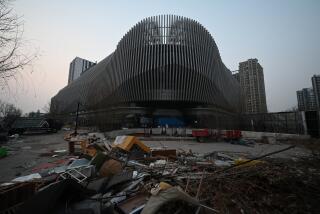China Struggles to Free Industry From Chains of Debt
- Share via
BEIJING — China’s Communist leaders are struggling to free state industry from a chain of debt that is strangling the economy, without admitting that the loss-making socialist system is bankrupt.
The so-called debt chain runs through a state sector that cannot pay its own way. One loss-making enterprise after another has defaulted on its debts, passing them down the line from supplier to supplier.
The China Daily reported last week that total outstanding debt among state enterprises stands at about $30 billion, up from $20 billion two years ago.
Footing the bill ultimately is the government, which is draining the national budget to prop up crumbling state industry and underpin the mountain of debt.
The problem of how to break the chain is debated daily in the media and has become a priority for Chinese leaders, who have assigned a man considered by many to be China’s most able bureaucrat to sort out the mess.
Zhu Rongji, a former mayor of Shanghai, brought a reputation as a can-do economic reformer to his present post as vice premier this year. He is touring the industrial northeast, the heartland of state heavy industry.
Economists doubt whether Zhu has been given the right tools to do the job.
Snapping the debt chain, they say, would involve mass bankruptcies among enterprises still cranking out 1950s-style products for a market more focused on the Space Age.
Chinese economists have been urging the government to let inefficient industries go to the wall under a 1988 bankruptcy law.
So far, not one state firm has been declared insolvent, although renewed discussion of bankruptcy in the state press may be softening public opinion for the shock.
The Economic Daily reported last week that a collectively owned printing and dyeing mill in Liaoning province recently was declared bankrupt with debts of about $120,000, twice its assets.
It was one of about a dozen collectives to be closed down since 1988.
“An enterprise like this one should be closed down for the sake of the nation,” factory Director Li Tingxuan was quoted as saying. He is now out of a job.
Allowing bankruptcies would strike a mortal blow at the state sector, which contributes half of the nation’s industrial output and more than 80% of its taxes. Some 40% of state firms are running at a loss.
China’s hard-line Communist leaders are not only committed ideologically to state-owned industry, but they fear the effects on social stability of massive layoffs that would be the inevitable result of bankruptcies.
Keeping industrial workers happy has become a priority for the leadership that crushed pro-democracy protests two years ago.
To illustrate the debt chain problem, the China Daily gave as an example the Shanghai No. 5 steel works, which it said was typical of other state enterprises.
The steel works owes its suppliers $94 million. Its excuse? It is waiting to collect on debts of $126 million, among them $2 million from a ball-bearing manufacturer in Liaoning province.
The bearing maker has problems of its own. It employs 200 people at a monthly cost of $37,000 specifically to collect on debts of $37 million.
Meanwhile, the steel works is having difficulty buying raw materials, settling utility bills and paying its workers.
The debt chain is coiled most tightly around the northeast, formerly Manchuria, where vast reserves of coal, oil and gas fuel heavy industries that produce machine tools, mining equipment, steel, rolling stock, trucks and washing machines.
More to Read
Sign up for Essential California
The most important California stories and recommendations in your inbox every morning.
You may occasionally receive promotional content from the Los Angeles Times.













